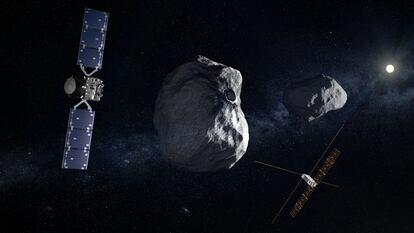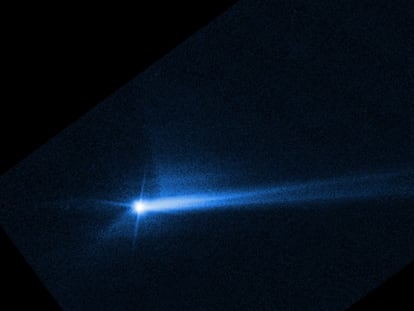‘Hera’, the first European planetary defense mission, launches successfully
The probe, an ESA project, will study the consequences of a deliberate impact by a NASA spacecraft against an asteroid in order to alter its trajectory

The European space defence mission Hera successfully lifted off from Cape Canaveral on Monday at 10:52 local time (16:52 CET) aboard a Falcon 9 rocket manufactured by the private company SpaceX. Very few observers were confident that the launch would comply with its planned programme: Hurricane Milton, approaching the coast of Florida, reached Category 5 during the early hours of Monday and is expected to make landfall Wednesday in the western extent of the U.S. state, placing serious doubts on the plans of the European Space Agency (ESA). As it transpired, one could almost say that against all (meteorological) predictions, the wind and lightning respected the scientists and engineers who had worked on the project and had spent the hours before the launch biting their nails and preparing for the worst.
The roar of the rocket’s engines and the cheers of those present to witness it marked a historic moment for European astronautics and the start of Hera’s journey, a trip that is scheduled to end in October 2026 when the spacecraft will arrive at the asteroid Dimorphos, 185,000 kilometres (114,953 miles) from Earth, to study the consequences of the deliberate impact of NASA’s DART spacecraft in September 2022. Together, DART and Hera are part of a project investigating how to divert the trajectory of a near-Earth object in order to have the necessary resources when humanity needs to do so to avoid the fatal collision of an asteroid with the planet’s surface: 66 million years ago, such an event wiped out the dinosaurs.

The impact of DART was historic, and Hera’s mission is to analyze what happened after the kinetic impact with this rocky body, 150 meters in diameter and similar in size to the Great Pyramid of Giza. Did a crater open up on its surface or did it alter the shape of the asteroid? The samples collected by Hera and by the two small satellites (cubesats, as engineers call them, because of their rectangular parallelepiped shape, similar to a shoebox) will serve to solve enigmas related to the mass, structure, composition, thermal characteristics and gravitational behavior of Dimorphos.
To do so, the mission will study the object for about six months, starting, if all goes well, in October 2026. The main spacecraft and the two cubesats, which will be released upon reaching the asteroid, are equipped with infrared and framing thermal cameras, as well as spectrometers and a laser altimeter that will allow scientists to draw a topographic map. One of the cubesats also carries a low-frequency radar, and the other incorporates a hyperspectral camera.
Dimorphos is part of a binary system of rocky bodies; it is the small moon that orbits around the main asteroid, Didymos, which is 780 meters in diameter. The impact of DART, which hit its target at a speed of six kilometers per second, knocked it out of its orbit for 32 minutes. European scientists who are in Cape Canaveral to attend the launch of a four-year project that has cost €363 million (almost $400 million) and involved 18 countries, used a criminological simile to define the mission of Hera, named after the Greek goddess of marriage, women and family: according to this comparison, Hera is the detective who goes to the scene of the crime to try to piece together what happened, and to draw conclusions to replicate this novel military planetary defense tactic in the future, if required.
A delay in the launch would certainly have been problematic. Conditions were forecast to be somewhat better for Tuesday, but the arrival of Milton, coupled with the planned launch of another NASA mission, Clipper, meant a delay of several days was expected. ESA had an orbital window for Hera, which opened on Monday and will close on October 27. After that, it would have been necessary to wait until 2025 or 2026 to resume the mission.
Sign up for our weekly newsletter to get more English-language news coverage from EL PAÍS USA Edition
Tu suscripción se está usando en otro dispositivo
¿Quieres añadir otro usuario a tu suscripción?
Si continúas leyendo en este dispositivo, no se podrá leer en el otro.
FlechaTu suscripción se está usando en otro dispositivo y solo puedes acceder a EL PAÍS desde un dispositivo a la vez.
Si quieres compartir tu cuenta, cambia tu suscripción a la modalidad Premium, así podrás añadir otro usuario. Cada uno accederá con su propia cuenta de email, lo que os permitirá personalizar vuestra experiencia en EL PAÍS.
¿Tienes una suscripción de empresa? Accede aquí para contratar más cuentas.
En el caso de no saber quién está usando tu cuenta, te recomendamos cambiar tu contraseña aquí.
Si decides continuar compartiendo tu cuenta, este mensaje se mostrará en tu dispositivo y en el de la otra persona que está usando tu cuenta de forma indefinida, afectando a tu experiencia de lectura. Puedes consultar aquí los términos y condiciones de la suscripción digital.
More information
Archived In
Últimas noticias
Welcome to the post-religion era: The idea of Christianity as the absolute truth has become obsolete
‘I thought you would like it’: The risky sexual practice popularized by TV shows and TikTok
The digitalization of tourism: ‘They promise experiences and gave us the worst possible one’
Mexican peso defies uncertainty with forecasts of a new period of stability in 2026
Most viewed
- Sinaloa Cartel war is taking its toll on Los Chapitos
- Reinhard Genzel, Nobel laureate in physics: ‘One-minute videos will never give you the truth’
- Oona Chaplin: ‘I told James Cameron that I was living in a treehouse and starting a permaculture project with a friend’
- Why the price of coffee has skyrocketed: from Brazilian plantations to specialty coffee houses
- Silver prices are going crazy: This is what’s fueling the rally










































